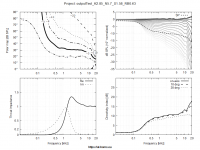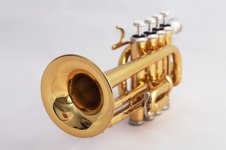You can change that manually in the file lib\scripts\report2.gpl.
Change these lines -
set xtics add ("0.2" 0.2, "0.5" 0.5, "5" 5, "" 15, "20" 20)
set logscale x
set format y "%.0f°"
set xrange [0.2:20]
to something like this:
set xtics add ("0.1" 0.1, "0.2" 0.2, "0.5" 0.5, "5" 5, "" 15, "20" 20)
set logscale x
set format y "%.0f°"
set xrange [0.02:20]
I think the horn is superb.
Easy peasy, thanks

If you closely look the designs I presented earlier you will notice that the area where the WG and the bass enclosure can interfere is actually quite small and this interference should be also pretty evenly distributed in time due to the enclosure shape. So I expect the effect to be very small indeed in this particular situation.
Are you referring to the measurements in #5038? To me that's a different situation with the waveguide being completely on top with no overlap and quite some air inbetween. But it does in some sense lead me back to the question from before: how much space does there need to be around the waveguide for it to remain acoustically independent? Be it vertically, horizontally, z-axis etc. Would a rectangular waveguide on top of a woofer cabinet gain independence when there's a gap of a couple of centimeters?
Why do you actually need to see that low? 🙂
I don't need to, but sometimes it's just nice look at the extremes
This is much easier and faster to measure than to simulate, I just need some enclosure for that. Or maybe I will use a paper box right now - I'm curious as well. At the moment we don't know the answer in any systematic manner, I think.how much space does there need to be around the waveguide for it to remain acoustically independent?
Measuring one of your perfectly terminated waveguides on top, in front and with various overlaps etc would be extremely revelatory. But that's a lot of work!
Personally I would also be curious to see what happens when you take a classic "waveguide in a baffle on top of woofer" speaker and detach the two parts and insert a gap. I could actually do that sometime, but would have to take a saw and split baffles into two pieces that took me a long time to plaster and sand into one smooth unit! lol
Personally I would also be curious to see what happens when you take a classic "waveguide in a baffle on top of woofer" speaker and detach the two parts and insert a gap. I could actually do that sometime, but would have to take a saw and split baffles into two pieces that took me a long time to plaster and sand into one smooth unit! lol
Twellmann may I ask what is the size of your waveguide?
Diameter around 640mm
Depth close to 200mm
Wowza, considerably smaller than I thought. Any chance to show annimage of the modeled device? 🙂
There really isn't if the rollback is done correctly. Maybe real measurements will help.My reasoning is just that there's too many variables involved to come to any real conclusions and/or their relevance.
Wowza, considerably smaller than I thought. Any chance to show annimage of the modeled device? 🙂

You can have the .stl
O640x200.stl - Google Drive
Last edited:
I expected a little smaller 🙂Wowza, considerably smaller than I thought.
That is about the same size (ignoring the symmetry) as the largest available waveguide with similarish design principles, the SEOS-24. Is there a way to model the SEOS waveguides in Ath4 to see how much of a leap this new generation of waveguides is?
Here are some measurements of SEOS24 SEOS 30 or 24: worth the upgrade? | AVS Forum
Looks like waveguides seen in this thread so far beat it at the high frequencies >5kHz at least, but those frequencies are so high it could be the driver throat matching the waveguide throat problem. Most compression drivers have conical exit section which requires some refinement to the waveguide which is easily done with ATH. Some examples in this thread somewhere.
Looks like waveguides seen in this thread so far beat it at the high frequencies >5kHz at least, but those frequencies are so high it could be the driver throat matching the waveguide throat problem. Most compression drivers have conical exit section which requires some refinement to the waveguide which is easily done with ATH. Some examples in this thread somewhere.
Last edited:
That's why it would be great to have an Ath4 model. To have a sort of real life reference and also see if these shortcomings are visible in the model as well.
The SEOS24 won't be nearly as nice vertically as it is horizontally.
I've no idea how to model that - I don't know how it's done.
I've no idea how to model that - I don't know how it's done.
Last edited:
Yes of course. And I expect it to be inferior to these new designs based on your software in every regard, but I would still very much like to know how much of a leap we're talking about.
I still believe there are benefits to non axi-symmetric waveguides depending on the use and implementation and it's easily available in a build quality that's hard to do DIY and it's cheaper too.
I still believe there are benefits to non axi-symmetric waveguides depending on the use and implementation and it's easily available in a build quality that's hard to do DIY and it's cheaper too.
Could you show us some example?I still believe there are benefits to non axi-symmetric waveguides depending on the use and implementation and it's easily available in a build quality that's hard to do DIY and it's cheaper too.
- Home
- Loudspeakers
- Multi-Way
- Acoustic Horn Design – The Easy Way (Ath4)